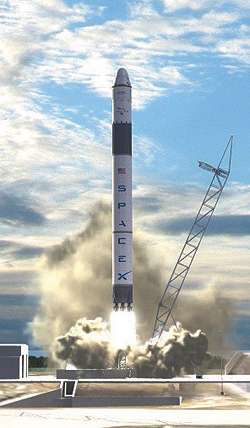|
SpaceX 's Dragon 's Dragon is a small orbital spacecraft designed for transporting people and goods to and from the
ISS is a small orbital spacecraft designed for transporting people and goods to and from the
ISS .
It has two configurations, an unmanned cargo configuration, and a
crew/passenger configuration capable of transporting up to seven people.
It is being built by a consortium led by SpaceX .
It has two configurations, an unmanned cargo configuration, and a
crew/passenger configuration capable of transporting up to seven people.
It is being built by a consortium led by SpaceX under NASA under NASA 's
Commercial Orbital Transportation Services 's
Commercial Orbital Transportation Services (
COTS (
COTS ) initiative. Dragon ) initiative. Dragon is also equipped with an
ISS is also equipped with an
ISS -compatible
dock that is exposed through a removable nosecone. Return to the
Earth's surface is achieved through a parachute-assisted splashdown and
recovery. -compatible
dock that is exposed through a removable nosecone. Return to the
Earth's surface is achieved through a parachute-assisted splashdown and
recovery.
Dragon is delivered into orbit on top of the Falcon 9 is delivered into orbit on top of the Falcon 9 two-stage launch vehicle, an expanded version of the Falcon 1 two-stage launch vehicle, an expanded version of the Falcon 1 rocket that completed a successful test launch to orbit on 28 September 2008 (after three prior failures). Both stages of the Falcon 9 rocket that completed a successful test launch to orbit on 28 September 2008 (after three prior failures). Both stages of the Falcon 9 are intended to be reusable. are intended to be reusable.
The intended use for the combined vehicle is
primarily to serve as a replacement for the Shuttle fleet after their
retirement, so space tourism is not an overt goal. Unlike vehicles aimed
explicitly at the space tourism market, the Dragon /Falcon 9 /Falcon 9 combination is not fully reusable, and so is unlikely to withstand
competition from a fully reusable orbital vehicle such as those proposed
by Scaled Composites
combination is not fully reusable, and so is unlikely to withstand
competition from a fully reusable orbital vehicle such as those proposed
by Scaled Composites and others. However, until such time as such vehicles become available
it may be the first privately financed space vehicle to be capable of
delivering people, space tourists or otherwise, to orbit.
and others. However, until such time as such vehicles become available
it may be the first privately financed space vehicle to be capable of
delivering people, space tourists or otherwise, to orbit.
|


No comments:
Post a Comment